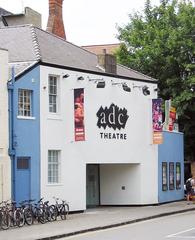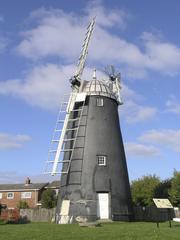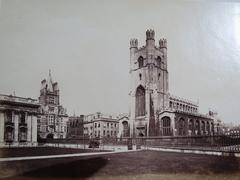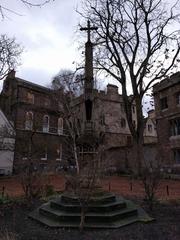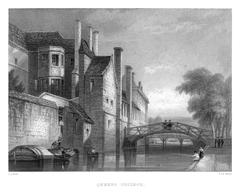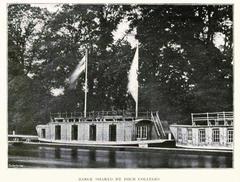Visiting Hours, Tickets, and Historical Sites: Comprehensive Guide to Cambridge University Botanic Garden
Date: 18/07/2024
Introduction
Welcome to the Cambridge University Botanic Garden, a verdant sanctuary nestled in the heart of Cambridge. This comprehensive guide aims to provide an in-depth exploration of this botanical treasure, covering its rich history, visitor information, and its significant contributions to research and conservation. The Cambridge University Botanic Garden is more than just a visual delight; it serves as a living laboratory with over 8,000 plant species, contributing significantly to botanical research, education, and conservation efforts. Established initially in 1760 as the Walkerian Garden, it has evolved into a 40-acre expanse that continues to captivate visitors and researchers alike (source). Whether you’re planning a visit or simply wish to learn more about this iconic garden, this guide offers everything you need to know—from visiting hours and ticket prices to special events and accessibility features.
Table of Contents
- Introduction
- History of the Cambridge University Botanic Garden
- Visiting Hours and Ticket Information
- Travel Tips and Nearby Attractions
- Special Events and Guided Tours
- Accessibility
- Visitor Experience and Educational Outreach
- Educational Programs
- Geographic and Thematic Displays
- Collections of Special Interest
- Conservation Efforts
- Research and Education
- Digital Resources and Databases
- Photographic Spots
- Sustainability
- Research and Conservation
- Visitor Information
- FAQ
- Conclusion
History of the Cambridge University Botanic Garden
Early Beginnings and the Walkerian Garden (1760-1849)
The Garden’s origins can be traced back to 1760, when the University purchased a 5-acre site on the outskirts of Cambridge for the establishment of a botanical garden. This early garden, known as the Walkerian Garden, played a crucial role in advancing botanical science and education.
Expansion and Development (1846-present)
In 1846, the Garden relocated to its current 40-acre site, allowing for significant expansion and development. Over the years, it has grown to house an impressive collection of over 8,000 plant species, serving as both a research facility and a public attraction.
Visiting Hours and Ticket Information
Opening Hours
The Cambridge University Botanic Garden is open daily from 10 AM to 6 PM, with the last entry at 5:30 PM. Please note that hours may vary depending on the season or special events.
Ticket Prices
- Adults: £6.00
- Concessions: £5.00
- Children under 16: Free (must be accompanied by an adult)
Tickets can be purchased at the entrance or online through the official website.
Travel Tips and Nearby Attractions
How to Get There
The Garden is conveniently located near the Cambridge city center and is accessible by public transport, bike, or car. Several bus routes stop close to the Garden, and bike racks are available on-site.
Nearby Attractions
While visiting the Garden, consider exploring other nearby attractions such as the Fitzwilliam Museum, King’s College Chapel, and the historic Cambridge Market Square.
Special Events and Guided Tours
The Garden hosts a variety of special events throughout the year, including plant fairs, educational workshops, and seasonal celebrations. Guided tours are also available, offering in-depth insights into the Garden’s diverse plant collections and history.
Accessibility
The Cambridge University Botanic Garden is committed to accessibility. The majority of the Garden is wheelchair accessible, and accessible restrooms are available. Assistance dogs are welcome.
Visitor Experience and Educational Outreach
Guided Tours
Join one of the Garden’s knowledgeable volunteer guides for a free tour to enhance your visit. Tours are offered on various themes, including seasonal highlights, the history of the Garden, and specific plant collections. Private group tours can also be arranged for a fee.
Family Activities
The Garden offers a range of family-friendly activities, including:
- Seasonal trails: Follow a themed trail through the Garden, discovering fascinating plants and solving puzzles along the way.
- School holiday activities: Participate in workshops, crafts, and interactive exhibits during school breaks.
- Family backpacks: Borrow a backpack filled with activities and resources to enhance your exploration of the Garden.
Educational Programs
As part of the University of Cambridge, the Botanic Garden is committed to education and research. The Garden offers a variety of programs for schools, universities, and adult learners, including:
- School visits: Tailored programs for different age groups, focusing on plant science, biodiversity, and conservation.
- University courses: The Garden serves as a living laboratory for university students studying botany, horticulture, and related fields.
- Adult learning: Participate in workshops, lectures, and courses on topics such as gardening, plant identification, and botanical art.
Geographic and Thematic Displays
The Garden’s layout reflects both geographical origins and plant evolutionary relationships. Visitors can embark on a botanical world tour, encountering diverse flora in areas like:
- The Cory Lodge Glasshouses: Providing controlled environments for a range of climates, these glasshouses showcase plants from tropical rainforests, arid deserts, and everything in between.
- The Limestone Rock Garden: This unique display features alpine plants from mountainous regions worldwide, thriving in well-drained, sunny conditions.
- The Woodland Garden: Offering a tranquil escape, this area replicates a woodland habitat, showcasing native and exotic trees, shrubs, and wildflowers.
Collections of Special Interest
Beyond geographical displays, the Garden boasts specialized collections that highlight specific plant groups and their unique characteristics:
- The Systematics Beds: Arranged according to their evolutionary relationships, these beds offer insights into plant classification and diversity.
- The Scented Garden: Designed to stimulate the senses, this collection features fragrant herbs, flowers, and shrubs, appealing to both sighted and visually impaired visitors.
- The Autumn Colour Collection: Bursting with vibrant hues in the fall, this collection showcases trees and shrubs known for their spectacular autumn foliage.
Conservation Efforts
The Cambridge University Botanic Garden is deeply committed to plant conservation, actively participating in global efforts to protect endangered species.
- The Sainsbury Laboratory: This state-of-the-art research facility, located within the Garden, focuses on plant-microbe interactions, contributing to the development of disease-resistant crops and sustainable agriculture.
- The Millennium Seed Bank Partnership: The Garden collaborates with the Millennium Seed Bank Project, contributing to the conservation of wild plant species through seed collection and storage.
- Ex-situ Conservation: The Garden provides a safe haven for numerous rare and endangered plant species, cultivating them outside their natural habitats to ensure their survival.
Research and Education
As an integral part of Cambridge University, the Botanic Garden plays a vital role in botanical research and education.
- University Research: The Garden’s diverse plant collections and research facilities support a wide range of scientific studies, from plant genetics and evolution to ecology and conservation.
- Public Engagement: Through educational programs, workshops, and guided tours, the Garden fosters public understanding and appreciation for the plant world.
- Horticultural Training: The Garden serves as a training ground for aspiring horticulturists, providing practical experience in plant cultivation and garden management.
Digital Resources and Databases
The Cambridge University Botanic Garden embraces technology to enhance accessibility and share its vast knowledge base with a wider audience.
- Online Herbarium: The Garden’s digital herbarium provides access to a wealth of botanical data, including high-resolution images and detailed descriptions of thousands of plant specimens.
- Garden Explorer: This interactive online tool allows users to explore the Garden virtually, discovering plant locations, learning about their characteristics, and planning their visit.
- Research Publications: The Garden actively publishes its research findings in scientific journals, contributing to the global body of botanical knowledge.
Photographic Spots
The Cambridge University Botanic Garden is a photographer’s paradise, with numerous picturesque spots to capture the beauty of nature:
- The Lake: A serene water feature surrounded by lush vegetation, perfect for tranquil landscape shots.
- The Rose Garden: Bursting with color and fragrance, this garden area is ideal for close-up floral photography.
- The Glasshouses: Offering a variety of exotic plants and unique architectural elements, the glasshouses provide endless photographic opportunities.
Sustainability
The Cambridge University Botanic Garden is committed to sustainable practices and environmental stewardship. The Garden implements various initiatives to minimize its ecological footprint, including:
- Water conservation: Rainwater harvesting and efficient irrigation systems help conserve water.
- Energy efficiency: The Garden utilizes energy-efficient lighting and heating systems.
- Waste reduction: Composting and recycling programs minimize waste.
- Sustainable sourcing: The Garden prioritizes sustainably sourced materials for construction and operations.
Frequently Asked Questions (FAQ)
Q: What are the Cambridge University Botanic Garden visiting hours?
A: The Garden is open daily from 10 AM to 6 PM, with the last entry at 5:30 PM. It is closed on Christmas Eve and Christmas Day.
Q: How much are tickets to the Cambridge University Botanic Garden?
A: General admission for adults is £6.00, with concessions available for seniors and children. Admission is free for Cambridge University students and staff with a valid ID.
Q: Is the garden accessible for visitors with disabilities?
A: Yes, the Garden is wheelchair accessible, with paths suitable for mobility scooters and accessible restrooms available on-site.
Q: Are there guided tours available?
A: Yes, the Garden offers expert-led guided tours that provide in-depth insights into the collections, history, and conservation efforts.
Conclusion
The Cambridge University Botanic Garden stands as a testament to the enduring relationship between nature and scientific inquiry. With its expansive collection of over 8,000 plant species, it offers a unique blend of natural beauty and academic rigor. Visitors can explore various themed gardens, participate in guided tours, and engage in educational programs that foster a deeper appreciation for plant science and conservation. The Garden’s commitment to accessibility ensures that everyone can enjoy its wonders. As a hub of research, it contributes to global efforts in plant conservation and sustainable agriculture. Whether you’re a seasoned botanist or a casual visitor, the Cambridge University Botanic Garden offers a rich and rewarding experience. For the latest updates, events, and more, follow the Garden on social media or visit their official website. Plan your visit today and immerse yourself in the captivating world of plants.
References
- Discover the Cambridge University Botanic Garden - History, Visiting Hours, and Ticket Information, 2024, Author (source)
- Explore Cambridge University Botanic Garden - Visiting Hours, Tickets, and Research Contributions, 2024, Author (source)
- Visiting the Cambridge University Botanic Garden - Hours, Tickets, and Visitor Tips, 2024, Author (source)
